Maintaining your cat’s oral hygiene is a crucial, yet often overlooked, aspect of their overall well-being. Daily brushing with the Best Cat Toothbrush can significantly prevent dental disease, a silent ailment affecting a vast majority of felines. While the thought of brushing your cat’s teeth might seem daunting, selecting the right tools can transform this essential task into a manageable and even routine part of your pet care regimen. This guide delves into the importance of feline dental care, what to look for in a cat toothbrush, and our top recommendations to help your beloved companion maintain a sparkling, healthy smile.
Why Feline Dental Health Matters: Understanding the Risks
Many cat owners underestimate the prevalence and severity of dental disease in cats. By the age of four, an alarming 50% to 90% of cats exhibit some signs of dental issues, according to experts at the Cornell Feline Health Center. Unlike humans, cats cannot vocalize their discomfort, leading these conditions to often progress unnoticed until they become severe.
In their natural habitat, wild cats would maintain oral hygiene by chewing on raw bones and fibrous materials, which naturally scrape plaque and tartar from their teeth. Domestic cats, however, largely rely on their owners for dental maintenance. While some commercial pet foods, such as certain kibble types, are marketed as beneficial for dental health, their efficacy in truly removing plaque and tartar is often limited. These products alone are rarely sufficient to prevent the buildup that leads to gingivitis and other more serious periodontal diseases.
The progression of dental disease begins with plaque, a sticky film of bacteria that constantly forms on teeth. If not removed, plaque hardens into tartar. Both plaque and tartar irritate the gums, leading to inflammation known as gingivitis. Left untreated, gingivitis can advance to periodontitis, a painful condition where the supporting structures of the teeth are damaged, potentially leading to tooth loss. Beyond oral pain and difficulty eating or drinking, severe dental disease can have systemic consequences. Bacteria from infected gums can enter the bloodstream, traveling to vital organs like the heart, kidneys, and liver, causing secondary infections and serious health complications. This highlights why preventive measures, particularly regular brushing with an effective cat toothbrush, are so vital for your cat’s long-term health. For a holistic approach to pet health, considering factors like diet is also key, much like choosing the optimal dog diet for our canine friends.
Factors to Consider When Choosing the Best Cat Toothbrush
Finding the perfect toothbrush for your feline companion involves understanding their unique needs and your own comfort level. The market offers a variety of designs, each with distinct advantages.
Types of Cat Toothbrushes
- Finger Brushes: These soft, silicone thimble-like brushes slip over your finger, allowing for direct contact and control inside your cat’s mouth. They are often a great starting point for cats new to brushing, as some felines find them less invasive than traditional handle brushes. While effective for gentle cleaning and introducing the sensation of brushing, their silicone nubs might be less effective at tackling significant tartar buildup compared to bristle brushes.
- Handle Brushes: Similar in design to human toothbrushes but with smaller heads and softer bristles, handle brushes offer better reach, especially for the back teeth. Many come with angled heads for easier maneuverability within a cat’s small mouth. They are generally more effective at removing plaque and tartar due to their bristle design. However, some cats may be more resistant to a traditional handle brush.
- Dual-Headed Brushes: Many handle brushes feature two heads—one small and one slightly larger. While the larger end is often too big for most cats, some innovative dual-headed brushes offer two functional ends, such as a polishing brush and a specialized pick for food particles.
Key Features to Look For
- Size: The toothbrush head must be small enough to fit comfortably in your cat’s mouth and reach all surfaces of their teeth. Micro-head brushes are excellent for kittens or cats with very small mouths.
- Bristle Softness: Opt for very soft bristles to avoid irritating your cat’s delicate gums. While firm enough to clean, they should be gentle.
- Ergonomics and Grip: A comfortable, secure grip on the handle is essential, especially when dealing with a wiggling cat. Rubberized handles or shorter designs can offer better control.
- Angled Head: An angled brush head can significantly improve accessibility to those hard-to-reach molars at the back of the mouth, making the brushing process more efficient and less stressful for both you and your cat.
- Material Quality: Look for toothbrushes made from food-grade, pet-safe materials, free from harmful chemicals like BPA or phthalates.
If you’re unsure which type will work best, consider purchasing a few different affordable options. Cats have individual preferences, and finding the one your cat tolerates (or even enjoys) is the most critical step. Remember to clean the toothbrush thoroughly after each use and replace it every three months, or sooner if the bristles become frayed. If you have multiple cats, each should have their own dedicated toothbrush to prevent the spread of bacteria.
Our Top Picks for the Best Cat Toothbrushes
Based on extensive research, expert recommendations, and consideration for cat comfort and owner ease of use, we’ve identified the top cat toothbrushes on the market. These selections aim to cater to various needs, from first-time brushers to those requiring advanced plaque removal.
1. Overall Best: Petsmile Professional Pet Toothbrush
The Petsmile Professional Pet Toothbrush stands out for its thoughtful design engineered for effective feline dental cleaning. What sets it apart are its uniquely tapered bristles, featuring shorter bristles in the front and taller ones at the back. This configuration excels at polishing a cat’s distinctively razor-like teeth, while a central row of bristles works to clean effectively beneath the gum line, a common area for plaque accumulation.
The bristles strike an ideal balance, being soft enough for sensitive gums yet firm enough to thoroughly get the job done. Both ends of this dual-headed brush are expertly angled, ensuring you can reach even the most challenging areas at the back of your cat’s mouth. A significant advantage is its secure, textured rubber grip, which provides comfort and control, particularly useful if your cat is prone to squirming. While it is dual-ended, most cats will primarily benefit from the smaller brush head.
What We Liked:
- Secure rubber grip for superior control.
- Tapered bristles effectively polish teeth and clean below the gum line.
- Angled brush heads facilitate reaching difficult back teeth and molars.
What We Didn’t Like:
- Higher price point compared to some other options.
- The larger brush head may be too big for most cats.
2. Best Finger Brush: Jasper 360° Finger Toothbrush
For cat parents looking for a gentle introduction to dental care, or for cats sensitive to traditional brushes, the Jasper 360° Finger Toothbrush is an excellent choice. Developed with the input of a veterinary dental specialist, these finger brushes are entirely covered with soft silicone nubs. This innovative 360-degree design allows for a comprehensive clean with minimal maneuvering, which is a major advantage when dealing with a pet that dislikes brushing. The soft texture is particularly crucial for nervous cats or those with sensitive gums.
While designed to adapt to various finger sizes by adding water, its primary benefit lies in the direct contact and gentle cleaning it provides. It’s an intuitive tool that offers a close connection to your cat’s mouth, though some owners might prefer the extended reach of a handle brush. The brushes are made from food-grade silicone, free from BPA or phthalates, ensuring safety. Each brush comes with its own plastic container for hygienic storage, and they can be sterilized by boiling. These qualities highlight the importance of safety and effectiveness in pet products, much like choosing safe bully sticks for dogs.
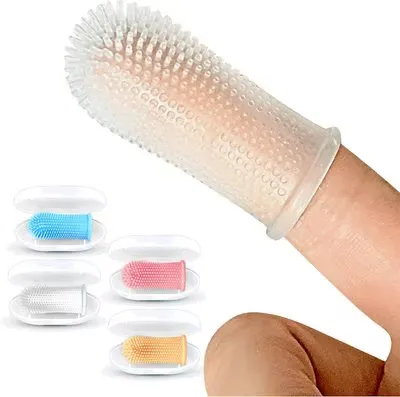 Jasper 360-degree finger toothbrush, a gentle option for cat teeth cleaning
Jasper 360-degree finger toothbrush, a gentle option for cat teeth cleaning
What We Liked:
- All-around silicone nubs ensure a comprehensive clean.
- Individual plastic containers for storage.
- Made from food-grade silicone, free from BPA and phthalates.
- Available in multi-packs, ideal for multi-cat households.
What We Didn’t Like:
- The water-expansion feature for finger fit might not be consistently effective.
- Not suitable for cats prone to biting fingers.
3. Best Dual-Headed: RYERCAT Dual-Sided Cat Toothbrush
The RYERCAT Dual-Sided Cat Toothbrush distinguishes itself from typical dual-ended designs by offering two genuinely functional brush heads. Instead of a redundant large brush, one end features a cat-sized polishing brush, while the other boasts a unique “pick” for dislodging food particles. This innovative approach enhances functionality beyond standard dual-sided brushes.
The rounded microhead brush, under a centimeter in size, uses medium-soft nylon bristles that are effective yet gentle. The pointed pick end, made with slightly rougher bamboo bristles infused with charcoal, is perfect for targeting stubborn food bits, especially from the back teeth. The charcoal infusion also aids in plaque absorption. The RYERCAT toothbrush is available in several attractive colors, which is not just an aesthetic choice but also practical for multi-cat homes, allowing for germ-free individual use. Crafted from biodegradable cornstarch, this product also reflects an eco-conscious choice.
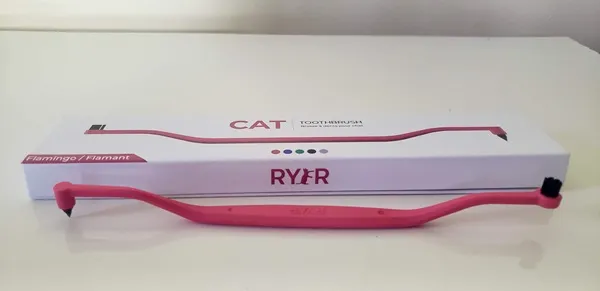 RYERCAT Dual-Sided Cat Toothbrush featuring a polishing brush and food particle pick
RYERCAT Dual-Sided Cat Toothbrush featuring a polishing brush and food particle pick
What We Liked:
- Two functional brush heads: one for polishing and one for picking food particles.
- Made from biodegradable cornstarch, an environmentally friendly choice.
- From a small, family- and woman-owned company.
- Available in multiple colors, great for identifying individual brushes in multi-cat homes.
What We Didn’t Like:
- It is the most expensive option among our top picks.
4. Best for Kittens: Mind Up Microhead Toothbrush
For the smallest mouths and most delicate gums, the Mind Up Microhead Toothbrush is specifically designed to meet the unique needs of kittens. Its super-small, round cluster of bristles and compact handle provide excellent control, making it ideal for introducing dental hygiene early on. The bristles are exceptionally soft, ensuring a gentle experience for sensitive kitten gums.
This toothbrush often comes with a spare brush head, allowing for replacement when the original wears down and helping to reduce plastic waste. The angled brush head is another beneficial feature, aiding in reaching tiny back teeth without causing discomfort. While some users have noted that the brush head can become loose with regular use, its initial quality and gentle design make it a standout choice for establishing good brushing habits from a young age.
 Mind Up Microhead Toothbrush, ideal for kittens and cats with small mouths
Mind Up Microhead Toothbrush, ideal for kittens and cats with small mouths
What We Liked:
- Tiny brush head and very soft bristles, perfect for kittens and small cats.
- Conveniently angled brush head for ease of use.
- Comes with a spare brush head, offering good value and less waste.
What We Didn’t Like:
- Some reviews suggest the brush head might become loose over time.
- Potentially less sturdy than other options.
5. Best Dental Kit: Sentry Petrodex Veterinary Strength Enzymatic Dental Kit
For new cat owners or those looking to refresh their dental care arsenal, the Sentry Petrodex Veterinary Strength Enzymatic Dental Kit offers a comprehensive solution. This all-in-one kit includes a small, angled toothbrush, a finger toothbrush, and a 2.5-ounce tube of enzymatic toothpaste specifically formulated for cats.
Developed by a veterinarian, the regular toothbrush features a slightly angled head and a shorter handle for better control. While its bristles are a bit more abrasive than some other soft-bristle options, they are still effective. The finger brush in this kit is quite sturdy, offering a different feel from more pliable silicone versions. A significant advantage of the enzymatic toothpaste is that it doesn’t foam, eliminating the need for rinsing. This simplifies the process, making it less stressful for both you and your cat. Many customers report that their cats enjoy the malt flavor, which can be a key factor in successful brushing.
What We Liked:
- Includes everything needed to begin or enhance oral care: two toothbrushes and enzymatic toothpaste.
- Both toothbrushes are dishwasher-safe for easy cleaning.
- Non-foaming toothpaste means no rinsing is required, simplifying the process.
What We Didn’t Like:
- The toothpaste contains sorbitol.
- The finger brush is less flexible compared to other silicone options.
6. Best Multi-Pack: H&H Pets Cat & Small Dog Toothbrush
Whether you’re managing dental care for multiple cats or simply want a supply of backup brushes, the H&H Pets Cat & Small Dog Toothbrush multi-pack provides an affordable and practical solution. These brushes are thoughtfully designed for both cats and small-breed dogs, ensuring an appropriate size that fits comfortably into smaller mouths.
The handle is shorter than many standard pet toothbrushes, offering a secure and comfortable grip that enhances control during brushing. The bristle area, measuring approximately 0.25” by 0.5”, is perfectly scaled for feline teeth. The bristles themselves are on the softer side, making them gentle enough for routine use without causing irritation. Available in packs of four or eight and in mint green and white colors, they allow for easy differentiation, which is crucial for hygiene in multi-pet households. This emphasis on practical, multi-use products extends to other areas of pet care, such as finding long lasting dog chews for large dogs that serve both dental and entertainment purposes.
 H&H Pets Cat and Small Dog Toothbrush multi-pack for consistent dental care
H&H Pets Cat and Small Dog Toothbrush multi-pack for consistent dental care
What We Liked:
- Cost-effective multi-packs (4 or 8 brushes).
- Available in two distinct colors for easy identification in multi-pet homes.
- Shorter handle provides a more secure and comfortable grip.
What We Didn’t Like:
- The brush heads are not angled, which might make reaching certain areas slightly more challenging.
7. Best Budget: Vetoquinol Enzadent Dual-Sided Cat & Dog Toothbrush
For pet owners seeking an economical yet effective solution for cat dental care, the Vetoquinol Enzadent Dual-Sided Cat & Dog Toothbrush is an excellent budget-friendly option. At a reasonable price, it offers the essential features needed for daily brushing without breaking the bank, especially considering toothbrushes need regular replacement.
The bristles are moderately soft, comparable to premium options like the Petsmile, striking a good balance between gentleness and cleaning power. A key feature is the ergonomically angled brush heads on both ends, designed to improve access to your cat’s back teeth. While the handle is quite long, which might be less comfortable for some users, its primary function as an affordable and effective cleaning tool remains. This toothbrush provides a solid basic option for maintaining your cat’s oral hygiene.
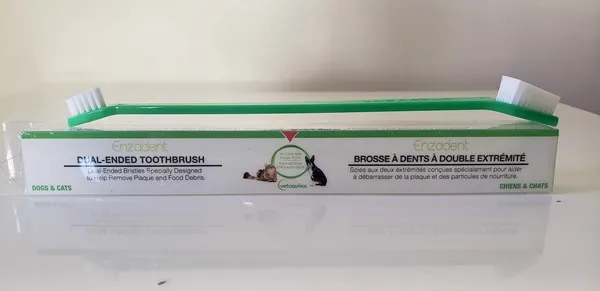 Vetoquinol Enzadent Dual-Sided Cat and Dog Toothbrush, a budget-friendly option
Vetoquinol Enzadent Dual-Sided Cat and Dog Toothbrush, a budget-friendly option
What We Liked:
- Very affordable, making replacements less costly.
- Moderately soft bristles suitable for most cats.
- Ergonomically angled brush heads improve access to back teeth.
What We Didn’t Like:
- Only available in one color.
- The larger brush head is likely too big for most cats.
- The long handle might be less comfortable to hold for some.
Tips for Brushing Your Cat’s Teeth Effectively
Once you’ve chosen the best cat toothbrush, the next step is to introduce the routine to your feline friend. Patience and positive reinforcement are key to a successful dental hygiene regimen.
- Start Early: The younger your cat is when you introduce brushing, the easier it will be for them to accept it.
- Acclimation: Begin by letting your cat lick pet-specific toothpaste from your finger. Never use human toothpaste, as it contains ingredients toxic to cats. Gradually introduce the finger brush or a soft cloth on your finger, rubbing it gently along their gums.
- Short Sessions: Keep initial brushing sessions very short, just a few seconds, gradually increasing the duration as your cat becomes more comfortable.
- Positive Reinforcement: Reward your cat with treats, praise, or playtime immediately after brushing to create a positive association.
- Technique: Angle the toothbrush at 45 degrees to the gum line, brushing in small, circular motions. Focus on the outside surfaces of the teeth, as this is where plaque tends to accumulate most.
- Consistency: Aim to brush daily. Consistency is more important than perfection in the beginning. Even a few times a week is better than nothing.
- Choose the Right Toothpaste: Always use an enzymatic, pet-specific toothpaste. These come in flavors cats typically enjoy, like malt or poultry.
- Know When to Stop: If your cat becomes agitated or stressed, stop the session and try again later. Forcing it can create a negative experience.
- Combine with Other Dental Aids: Even with regular brushing, incorporating dental treats or water additives can offer additional protection, ensuring comprehensive feline dental health. Finding the right dental aids for pets is similar to researching durable dog chews that promote canine oral health.
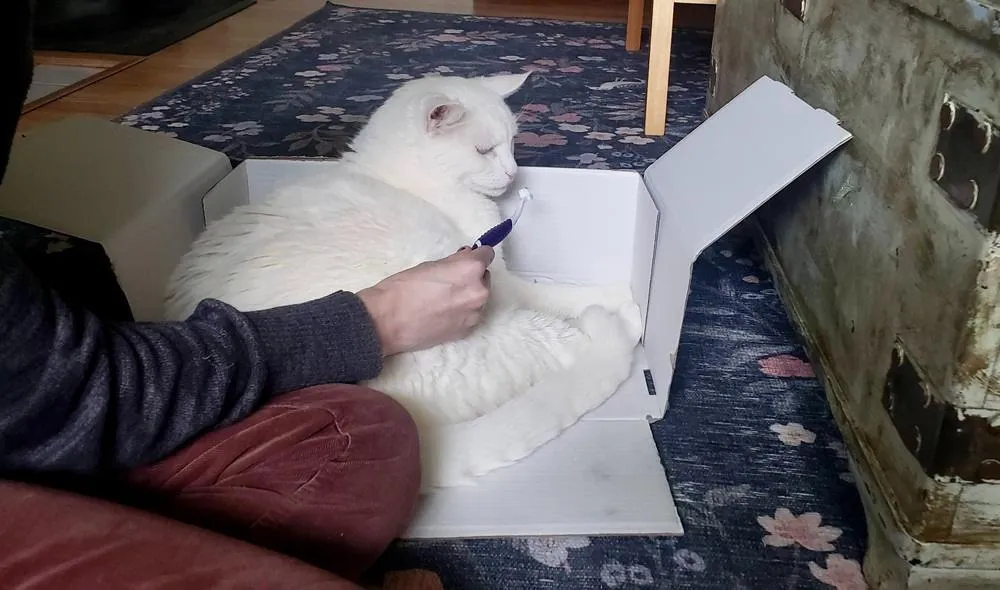 White cat curiously sniffing a cat toothbrush with toothpaste, illustrating introduction to dental care
White cat curiously sniffing a cat toothbrush with toothpaste, illustrating introduction to dental care
Alternative Dental Care Options for Cats
While daily brushing with the best cat toothbrush is the gold standard for maintaining feline dental health, it’s not always feasible for every cat or owner. Fortunately, several alternative methods can help promote oral hygiene. These options can also complement a brushing routine for enhanced protection.
- Dental Diets: Prescription dental diets are specially formulated with a unique kibble structure that helps scrape plaque off teeth as the cat chews. Look for products with the Veterinary Oral Health Council (VOHC) Seal of Acceptance.
- Dental Treats: Certain cat treats are designed with abrasive textures or specific ingredients that help reduce plaque and tartar. Again, prioritize VOHC-approved treats to ensure efficacy.
- Water Additives: These liquids are added to your cat’s drinking water and contain ingredients that help reduce bacteria and plaque formation in the mouth.
- Oral Rinses and Gels: Antiseptic rinses and gels can be applied to the gums to help control bacteria. While less effective than brushing, they are a good interim solution or a supplement for cats who resist brushing.
- Powder Supplements: Some supplements can be sprinkled over food, working systemically to reduce plaque and tartar.
- Professional Dental Cleanings: Regular professional cleanings by a veterinarian are essential, especially if your cat has significant plaque and tartar buildup that cannot be removed by brushing alone. These procedures involve scaling and polishing under anesthesia, allowing for a thorough examination and addressing any underlying issues. For a healthy pet, ensuring proper nutrition is also fundamental, whether it’s understanding what is the best snack for dogs or a balanced diet for cats.
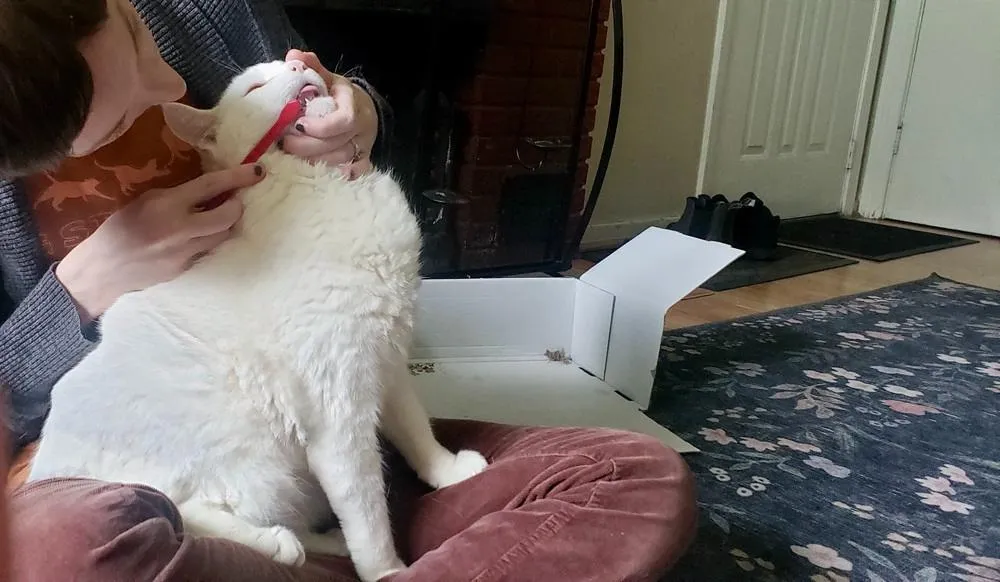 Person gently brushing a cat's teeth with a Sentry brand cat toothbrush, demonstrating proper technique
Person gently brushing a cat's teeth with a Sentry brand cat toothbrush, demonstrating proper technique
Frequently Asked Questions About Cat Toothbrushes
What type of toothbrush is best for a cat?
The most effective cat toothbrush is ultimately the one your cat will tolerate. While traditional handle brushes with soft bristles are generally more effective for removing plaque and reaching back teeth, some cats are much more accepting of a soft silicone finger brush. Consider your cat’s temperament and your comfort level. It’s perfectly fine to start with a finger brush and transition to a handle brush as your cat becomes more accustomed to the routine.
Can I brush my cat’s teeth with my finger?
While not as effective as a dedicated cat toothbrush, using your finger wrapped in a piece of gauze can be a good starting point, especially for introducing toothpaste and the sensation of brushing. It’s significantly better than doing nothing at all. For new brushers, this can be an excellent way to acclimate your cat to having their mouth handled before introducing a brush.
Is it too late to brush my cat’s teeth?
It is never too late to start! Even older cats can be acclimated to teeth brushing, though it might require more patience and a slower introduction process. If your older cat has significant tartar buildup, consult your veterinarian for a professional dental cleaning first. Brushing alone cannot remove hardened tartar. Once the vet has removed the tartar, you can begin a regular brushing routine to prevent future buildup.
How do I keep my cat’s teeth clean without brushing?
While daily brushing is the gold standard, other methods can support oral hygiene if brushing isn’t possible. These include veterinary-approved dental treats, specific dental kibble, water additives, oral rinses, and topical gels. Look for products that have earned the Veterinary Oral Health Council (VOHC) Seal of Acceptance, as this indicates they have met standards for plaque and tartar control. These alternatives are also excellent supplements to a regular brushing routine.
How often should I replace my cat’s toothbrush?
You should replace your cat’s toothbrush every three months, or sooner if the bristles become visibly frayed or damaged. Just like human toothbrushes, pet toothbrushes wear out and become less effective over time. Regular replacement also helps to ensure hygiene and prevent the buildup of bacteria on the brush itself.
Conclusion
Selecting the best cat toothbrush is a pivotal step towards safeguarding your feline companion’s long-term health and preventing painful dental diseases. While the array of options can seem overwhelming, prioritizing features like brush head size, bristle softness, and ergonomic design will guide you to a suitable choice. Remember, consistency and patience are paramount when introducing and maintaining a dental hygiene routine. By committing to regular brushing and supplementing with other veterinary-approved dental aids, you can ensure your cat enjoys a healthier, happier life with a bright, clean smile. Consult your veterinarian for personalized advice on the most appropriate dental care plan for your unique cat.
References
- Cornell Feline Health Center. (n.d.). Feline Dental Disease. Retrieved from https://www.vet.cornell.edu/departments-centers-and-institutes/cornell-feline-health-center/health-information/feline-health-topics/feline-dental-disease
- Veterinary Oral Health Council (VOHC). (n.d.). Accepted Products for Cats. Retrieved from https://vohc.org/accepted-products/#cats
